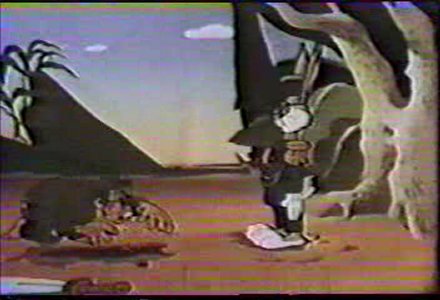DrForester
Kills Photobucket
..or movies
In the midst of last weeks South Park, Time Magazine has put together a list of the 10 10 controversial cartoons.
http://www.time.com/time/specials/packages/completelist/0,29569,1984966,00.html
10. Speedy Gonzales

9. South Park and Scientology

8. Aladdin
http://www.youtube.com/watch?v=eEGlJP4X4vc
7. Pokemon's Seizure Episode

6. Family Guy And Sarah Palin

5. The Boondocks

4. Song of the South

3. The Simpson's and Brazil
http://www.youtube.com/watch?v=invBjPmY8iE
2. The Censored Eleven
http://www.youtube.com/watch?v=3P5jyyxCgIo
http://en.wikipedia.org/wiki/Censored_Eleven
1. South Park And Muhammad

Had never even heard of the censored 11 before. Interesting stuff.
In the midst of last weeks South Park, Time Magazine has put together a list of the 10 10 controversial cartoons.
http://www.time.com/time/specials/packages/completelist/0,29569,1984966,00.html
10. Speedy Gonzales

Speedy Gonzales America's favorite fleet-footed, sombrero-clad, Mexican-accented Looney Tunes mouse hit a road bump in 1999 when the Cartoon Network pulled him from the air. (The likely cause was ethnic stereotyping: Speedy's Mexican buddies are portrayed as lazy boozehounds.) Calling the popular rodent a positive role model, however, fans and lobbyists including supporters of the League of United Latin American Citizens, the U.S.' oldest Hispanic-American rights organization campaigned to resurrect him, and by 2002 he was zooming across the airwaves once more.
9. South Park and Scientology

There was no way The Church of Scientology, of all things, would escape South Park's satirical animation. The same goes for Tom Cruise, the Church adherent whose proclivities have often been questioned. The episode "Trapped in the Closet," which aired November 16, 2005, made fun of both. When it wasn't rebroadcast as scheduled on March 15, 2006, rumors swirled. Some said Cruise was behind it, though he denied any involvement. That week, another Scientologist, Isaac Hayeswho voiced Chef on the showsaid in a statement that he was leaving South Park, taking issue with the show's portrayal of religious beliefs. "Trapped in the Closet" was shelved that week; the rerun "Chef's Chocolate Salty Balls" aired in its place.
8. Aladdin
http://www.youtube.com/watch?v=eEGlJP4X4vc
The lyrics of Disney's cartoon musicals aren't generally known for their edginess, but the opening song of 1992's Aladdin left some viewers steaming. As the movie begins, a character describes his Arabian home as a place "where they cut off your ear/ If they don't like your face," and concludes, "It's barbaric, but hey, it's home." Arab-Americans said the line played on stereotypes and asked that it be removed. "Can an Arab-American child feel good after seeing Aladdin? The answer is no," an official with the American-Arab Anti-Discrimination Committee told Variety. (Critics also objected to a scene in which an Arab merchant attempts to slice off Princess Jasmine's hand.) Disney defended the movie, calling it the first film in years to feature an Arab hero and heroine, but the company agreed to change the lyric in the home-video and CD versions (the new version: "Where it's flat and immense/ And the heat is intense"). To the dismay of critics, however, the "barbaric" line remained. In a 1993 editorial titled "It's Racist, But Hey, It's Disney," the New York Times countered, "To characterize an entire region with this sort of tongue-in-cheek bigotry, especially in a movie aimed at children, borders on barbaric."
7. Pokemon's Seizure Episode

On December 16, 1997, a mysterious plague swept through Japan: in a single evening, some 12,000 people reported symptoms ranging from nausea to seizures, and nearly 700 mostly school kids were rushed to the hospital. The reason: they had all viewed an episode of the popular anime cartoon Pokemon featuring about 5 seconds of flashing red and blue lights. The combination can trigger seizures in people with photosensitive epilepsy. (The reason for the nausea or dizziness is less clear; some analysts suspect it stemmed from anxiety provoked by early media coverage of the event.) The following day, TV Tokyo issued an apology and suspended the program. Not long after, Japanese broadcasters teamed up with medical officials to create new guidelines for animated programs, limiting the speed at which images flash, among other changes. Two viewers stayed in the hospital for more than 2 weeks.
6. Family Guy And Sarah Palin

Sometimes one line is all it takes. In a February episode of Family Guya show not exactly intended for the entire familya character with Down syndrome says, "My dad's an accountant, and my mom's the former governor of Alaska." Cue the real former governor of Alaska, Sarah Palin, whose youngest child, Trig, has Down syndrome. She was not happy with the episode, and made it known on Facebook and on the air.
But Andrea Fay Friedman, the actress who played the Family Guy character and who herself has Down syndrome, said in an email to the New York Times,"I guess former Governor Palin does not have a sense of humor." She also noted, "My parents raised me to have a sense of humor and to live a normal life. My mother did not carry me around under her arm like a loaf of French bread the way former Governor Palin carries her son Trig around looking for sympathy and votes." Ouch.
5. The Boondocks

The trouble began before The Boondocks now a Peabody Award-winning send-up of American race relations and stereotypes ever even hit the airwaves. In print, the 300-newspaper comic strip on which the show was based toned down its frequent use of the n-word with profanity symbols. But in July 2005, a few months before the TV version aired on the Cartoon Network, creator Aaron McGruder declared that the show would use no bleeps. "I think it makes the show sincere," he said. "I understand the word offends a lot of people. But that's what late-night cable is for."
4. Song of the South

You probably haven't seen Disney's 1946 film Song of the South, but you've definitely heard it. Its signature song, "Zip-a-Dee-Doo-Dah," won a 1947 Academy Award, and the Br'er Rabbit animation sequences have been used in several TV spots and Disney specials over the years. But there's no denying the fact that by today's standards, the film is rather racist. Set in the postCivil War South, the movie in which a former slave named Uncle Remus regales children with amusing stories depicts an offensively "idyllic" master-slave relationship, as the NAACP once described it. Adam Clayton Powell Jr. considered the feature's depictions of happy slaves an "insult to American minorities." Disney has declined to release the film on video in the U.S., fearing an outcry over the crude stereotypes.
3. The Simpson's and Brazil
http://www.youtube.com/watch?v=invBjPmY8iE
The Simpsons have been on the air for more than 20 years, so maybe it's not so surprising that of the hundreds of episodes, at least one would inspire a nation to threaten FOX with a lawsuit. In 2002's "Blame It on Lisa," the family heads to Rio de Janeiro, where all sorts of Latin American stereotypes play out and the family has a less than idyllic trip. Homer gets kidnapped by a cab driver, and Bart watches a children's show called "Teleboobies" (that's before he's swallowed by a snake, of course). The episode hadn't even aired abroad before Rio's tourism board said it would hurt efforts to bring in visitors and threatened legal action.
Said executive producer James Brooks: "We apologize to the lovely city and people of Rio de Janeiro, and if that doesn't settle the issue, Homer Simpson offers to take on the President of Brazil on Fox's Celebrity Boxing."
2. The Censored Eleven
http://www.youtube.com/watch?v=3P5jyyxCgIo
http://en.wikipedia.org/wiki/Censored_Eleven
Nothing shows its age faster than humor. In 1968, having deemed 11 Looney Tunes and Merrie Melodies cartoons popular in their own time two decades prior too politically incorrect to air, United Artists withheld them from syndication. The "Censored 11" haven't aired on TV since, but clips have crept online, giving today's audiences a window into cringeworthy racist stereotypes once considered fit for Saturday-morning fun. A 1941 episode called "All this and Rabbit Stew" showed Bugs Bunny hunted by a dim-witted, black gambler (later reimagined as Elmer Fudd). In 1943, "Coal Black and De Sebben Dwarfs" parodied Disney's Snow White with an all-black cast. (Innovative despite its dubious content, the cartoon was named one of the 50 Greatest of All Time in 1994 based on votes from more than 1000 animation-industry professionals.) And 1944's "Goldilocks and the Jivin' Bears" likewise repopulates the popular story with an all-black cast, turning the Three Bears into jazz musicians, with many characters drawn in blackface style. It makes South Park look positively sensitive.
1. South Park And Muhammad

During 14 years on the Comedy Central air, South Park has satirized nearly everyone and everything. But after the April 14 broadcast of the series' 200th episodewhich included a Muhammad character hidden from view, thanks to a bear suita post on an extremist Muslim website threatened show creators Matt Stone and Trey Parker: "We have to warn Matt and Trey that what they are doing is stupid, and they will probably wind up like Theo Van Gogh airing this show." A picture of the murdered Dutch filmmaker and the listing of addresses on the site belied the insistence that this was a warning and not a threat.
The following week, South Park's 201st episode also included Muhammad...sort of. Turns out it was Santa Claus under the bear suit. Instead, Stone and Parker "showed" Muhammad under a black box and the word CENSORED. But the non-images aside, all references to the prophet were also bleeped. According to a statement from Stone and Parker, "It wasn't some meta-joke on our part. Comedy Central added the bleeps. In fact, Kyle's customary final speech was about intimidation and fear. It didn't mention Muhammad at all but it got bleeped too."
This is not the first time South Park has weighed in on the issue of depicting Muhammad. In 2006, following the Danish cartoon controversy, Comedy Central also put Muhammad behind a black CENSORED box. Yet the prophet had actually made his South Park debut years before: in 2001, during the show's fifth season, he was a member of "The Super Best Friends," appearing on screen with the likes of Jesus, Moses, Buddha, Lao Tzu, Joseph Smith, and Krishna.
Had never even heard of the censored 11 before. Interesting stuff.




